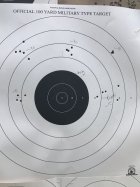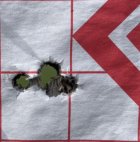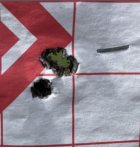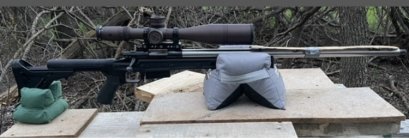I disagree. Unless I say that I am repeating something that I have heard (usually from a good source, based on his experiences) I have done it myself, multiple times. Others who have replied here fall into the same category. Except for short range benchrest shooters, most do not load at the range. Most do not put out wind flags. Those of us who do and have for years, routinely change our loads to get better results on a given day. Doing that virtually every time we shoot builds up a considerable reservoir of experience with making changes and seeing what the result was.Like most things reloading, the answers you get will all be based on conjecture, with some generational myths and lore sprinkled in.
Install the app
How to install the app on iOS
Follow along with the video below to see how to install our site as a web app on your home screen.
Note: This feature may not be available in some browsers.
You are using an out of date browser. It may not display this or other websites correctly.
You should upgrade or use an alternative browser.
You should upgrade or use an alternative browser.
Seating depth…what does it do?
- Thread starter David Christian
- Start date
I'm not saying that seating depth does or doesn't effect precision.
I'm more talking about the why. There seems to be a lot of conjecture around what is actually happening.
Also, there's a lot of faults to how we shooters test. I'm not going to get into that, but our testing methods as individual shooters is beyond flawed and faulty - many flawed conclusions have been developed through a reloader/shooters observational experience.
I'm more talking about the why. There seems to be a lot of conjecture around what is actually happening.
Also, there's a lot of faults to how we shooters test. I'm not going to get into that, but our testing methods as individual shooters is beyond flawed and faulty - many flawed conclusions have been developed through a reloader/shooters observational experience.
Dusty Stevens
Shiner
If you ever shot thru a test barrel youd see the pressure change of the changing case volume. That may give you more of an idea of how and why it changesI'm not saying that seating depth does or doesn't effect precision.
I'm more talking about the why. There seems to be a lot of conjecture around what is actually happening.
Also, there's a lot of faults to how we shooters test. I'm not going to get into that, but our testing methods as individual shooters is beyond flawed and faulty - many flawed conclusions have been developed through a reloader/shooters observational experience.
If you ever shot thru a test barrel youd see the pressure change of the changing case volume. That may give you more of an idea of how and why it changes
Undoubtedly there's a relationship between seating depth and pressure.
Different rifles, chambers, powders, bullets, etc. Different opinions different results. Personally I've only seen one "test" that I feel actually shows some relationship between accuracy and seating depth. That test is detailed on the Precision Rifle Blog. It is actually a series of articles on the work of Mark Gordon. I know that Berger/Litz also did a lot of work but I haven't seen the actual results. Most forum posts show the results of only one test by one shooter.

 precisionrifleblog.com
precisionrifleblog.com

Bullet Jump: Is Less Always Better?
About 2 years ago, Mark Gordon shared some preliminary research he’d conducted with the Applied Bal...
Jeff Porter
Gold $$ Contributor
I shoot sling prone. This particular example of a Nosler 80gr with 23.2 of 8208 liked 0.040” real well. Used the larger steps to identify the sweet spot then tweak on either side to verify. 0.020” was a scatter node 10 and 30 off were not horrible. I could dig up other examples of different loads with 0.010” and others with 0.130”. I run the Berger jumps as a screening test. Also… for magazine length ammo. Longest possible is not always best. Groups can get rounder and tighter by pushing in up to 0.020” shorter. Particularly with shorter stubby light bullets.


You can clearly see where the next test will be.View attachment 1387807
A friend of mine sent me a sample of the most interesting long range seating depth review I’ve seen.
One shot per depth increment, very cool. (hopefully he doesn’t mind if I share this )
Nailed on post #2. I’m amazed it has continued for 4 pages past that. I had no idea that there were so many theories. I thought it was settled decades ago, in a word, harmonics.Barrel time- exit point in the vibration cycle of the barrel moved by a few milliseconds to find the node of best accuracy.
Coyotefurharvester
Silver $$ Contributor
Just thinking out loud, the necks on brass can be very "uneven" in hardness around the circumference. This creates uneven friction(drag as bullet begins to move) between the bullet and neck brass interface(rotationally). Slight differences in seating depth reduce or increase the uneven friction. Would explain why brass consistency 1.premium vs cheap brass 2. annealing vs no annealing 3. Number of times brass has been fired. 4. Jam seating vs jump. 5. Neck tension. All can show confirmed on target performance.
CharlieNC
Gold $$ Contributor
While I believe harmonic timing is one aspect, I also think many of the other factors which were mentioned are also at play via a different mechanism. And the speculated impact of milliseconds is certainly way off.Nailed on post #2. I’m amazed it has continued for 4 pages past that. I had no idea that there were so many theories. I thought it was settled decades ago, in a word, harmonics.
If seating depth merely changes barrel timing AND ONLY barrel timing, then couldn't the proper barrel timing be accomplished with powder charge by itself?Because David ask for all angles the discussion has continued. Myself I’m into barrel timing and seating changes that fine tune the exit timing beyond powder charge increments seen on a chronograph.
We are able to measure with the FX120i, which many of us have, to .02 grains.
I think if we are to assume that seating depth only affects barrel exit timing, then I think there needs to be an answer as to why we couldn't use any seating depth with a specific powder charge to accomplish finding the right load.
I like Erik Cortina’s method and approach. He’s got hours of videos that are very informative. Not saying it’s the only way but it makes sense to me.
Didn't mean to specifically point out what you said. Moreso it's been said throughout the thread.I’m not sure I said seating changes barrel timing rather fine tune. I can tune powder within a tenth gr or kernel and be confident the timing is good yet still influence groups vertical point of impact and irregularities with seating variations.
Added; I don’t pretend to know what’s going on inside a barrel, I’m just trying to describe what I see on paper although I’m but probably not doing a good job of that.
Jim
Ccrider
Gold $$ Contributor
I see this in every ppc load.With Sr Br rifle you can induce vertical and horizontal with seating depth. It can be seen on the target. Probably really shows up at Lr.
Later
Dave
With all of your years as a test shooter for manufacturers, are you willing to share your knowledge and experience? I’m seriously curious to hear your opinions.Undoubtedly there's a relationship between seating depth and pressure.
Alex Wheeler
Site $$ Sponsor
Seating depth does stuff to the tune that that does stuff on target. Thats my technical answer. Most of the time we think in barrel time and exit time. Seating does seem to relate more to touch point than anything. I can cut a barrel to length with a tape measure. They may vary a bit but they will like the same jam or jump to the .001". And in LR we get a very small window, maybe .002 or .003. It just matters. Why exactly, I will leave to smarter people.
Similar threads
- Replies
- 61
- Views
- 14,336
- Replies
- 2
- Views
- 1,029
- Replies
- 50
- Views
- 7,251
Upgrades & Donations
This Forum's expenses are primarily paid by member contributions. You can upgrade your Forum membership in seconds. Gold and Silver members get unlimited FREE classifieds for one year. Gold members can upload custom avatars.

Click Upgrade Membership Button ABOVE to get Gold or Silver Status.
You can also donate any amount, large or small, with the button below. Include your Forum Name in the PayPal Notes field.
To DONATE by CHECK, or make a recurring donation, CLICK HERE to learn how.

Click Upgrade Membership Button ABOVE to get Gold or Silver Status.
You can also donate any amount, large or small, with the button below. Include your Forum Name in the PayPal Notes field.
To DONATE by CHECK, or make a recurring donation, CLICK HERE to learn how.













